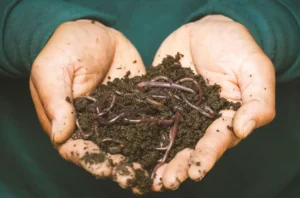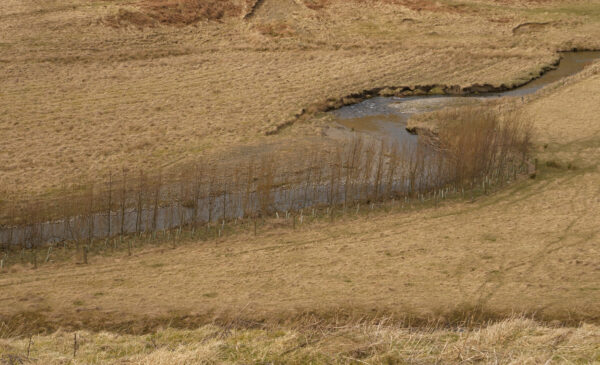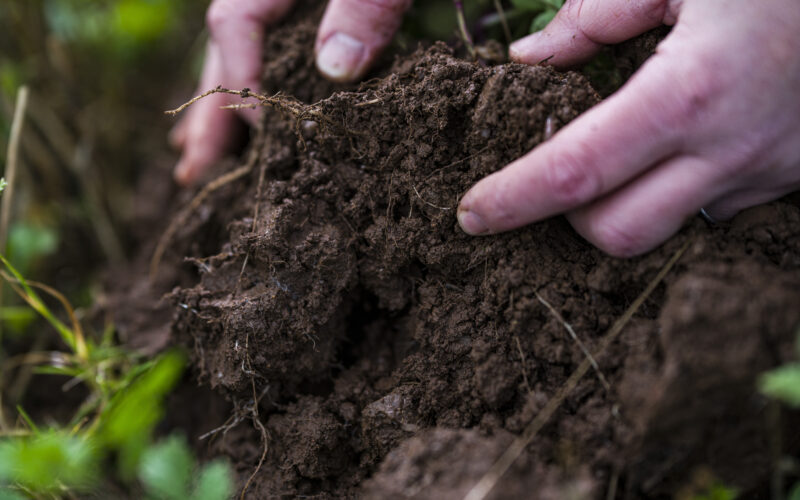The importance of soils
Soils underpin all nature-based systems, therefore, are vital in supporting Scotland’s economy. For example, we all rely on soils to provide a range of services including;
- the production of goods such as food, whiskey and timber,
- to support climate regulation through carbon sequestration, particularly across peatlands, grasslands and forestry soils
- water quality and buffering contamination risk
- Flood resilience through water holding capacity and soils influencing the flow of water within catchments
- Biodiversity – Soils contain 25% of global biodiversity [1] and supports wider environmental biodiversity
- Source of pharmaceuticals and genetic resources
- Societal benefits such as green spaces for wellbeing,
- Cultural heritage and archaeological preservation
Risks to soils and our wider environment
However, the health of our soils are at risk of being degraded and in some cases at risk of physically being eroded away, having significant impacts on the range of services soils provide. The Scottish Soil Framework (2009)[2] listed climate change impacts on soil, the loss of organic matter (and carbon) and soil sealing as the highest three risks to Scottish soils. Environmental Standards Scotland (2024)[3] listed soil erosion and landslide, soil compaction, loss of biodiversity and inconsistent approaches to data collection and monitoring as high risks to Scottish soils. The loss of organic matter (and carbon), water retention/capacity of soils, soil contamination, the application of wastes to land and the landfilling of waste soil, were classified as ‘medium’ risks to Scottish soils according to ESS (2024). A recent study by AHDB[4] outlined the climatic impacts on soils. For example heavier rainfall events leading to erosion, compaction/poaching risks (e.g. from livestock and machinery) and low rainfall causing soil aridity (dryness) reducing water availability to grassland and crops (including forage crops), impacting grazing productivity and quality. The report highlighted that these events could influence run-off and diffuse pollution of nutrients (N and P) into nearby waters as well as increase nitrous oxide (N2O) emissions, cause grass and crop damage, and reduce access to farmland.
These risks threaten the future security of Scottish soils and not only have environmental consequences but also have knock on effects with respect to the economic costs associated with poor soil management. For example, in Scotland Baggaley et al (2023)[5] highlighted the socio-economic repercussions of up to £49 million in yield losses annually due to soil compaction and up to £26 million per year in additional fertiliser use required to operate on compacted soils. The study also highlighted the impact of soil sealing and compaction combined with increased flood risk and insurance claims estimated at up to £76,000 per household.
Protecting agricultural soils
A key component of sustainable soil management in agriculture is the conservation (or improvement) of soil organic matter, this is due to
- Approximately 58% of soil organic matter (SOM) is carbon and so improving and/or retaining SOM contributes to soil organic carbon stocks
- SOM contains key nutrients such as nitrogen, phosphorus, sulphur, potassium and magnesium, which are key for soil fertility supporting crop and plant growth. You can review your soil organic matter and nutrient composition through soil laboratory test (such as those within the Preparing for Sustainable Agriculture, whole farm plan)
- Due to the chemistry of SOM, it contributes to water and nutrient retention, water holding capacity and drainage which will improve the resilience of soils during episodes of flooding and drought. You can test drainage on farm with an infiltration test.
- Supporting diverse production promotes diverse root structures, which help bind and anchor soil particles together (forming friable soil ‘aggregates’) reducing the risk of compaction and erosion. You can review your soil structure by performing a visual evaluation of soil structure test (VESS) as well as your aggregate stability (or how susceptible your soil is to be washed away) by performing a slake test.
In agriculture there are a range of management practices which are encouraged to conserve and/or increase soil organic matter contents and promoted to help build resilience. For example, the Scottish Government outlines many nature-friendly farming practices within the Agricultural Reform List of Measures[6] which is linked to financial support within the Agricultural Reform Route Map[7]. There has been a lot of attention to increase soil organic matter contents, however it is worth noting that it is just as important to conserve existing SOM, especially where SOM contents are already high.
Future developments in securing Scottish Soils

Currently in Scotland there no soil-specific policy focused on soil protection and/or improvement (unlike water and air). However, recent policy developments have included soil specific objectives which contribute to soil protection in Scotland. For example, the 2023 National Planning Framework (Policy 5)[8], provides the aim “to protect carbon-rich soils, restore peatlands and minimise disturbance to soils from development”. Scottish Government’s Vision for Agriculture (2022) includes soil testing and a range of agricultural reform measures contributing to sustainable soil management. More recently, the 2024 Scottish Biodiversity Strategy (Objective 3)[9] outlines objective to “Embed nature positive farming, fishing and forestry” which includes the action to “ensure increased uptake of high diversity, nature-rich, high soil carbon, low intensity farming methods while sustaining high quality food production”. Scottish Government has also commissioned a project through ClimateXChange to develop a route map for Scottish soils, which reviews where soil protection exists and explores opportunities for collaborative approaches for soil protection across policy themes. Outputs of the project are due to be published in Spring 2025.
[1] FAO Dig in for World Soil Day 2020
[2] The Scottish Soil Framework (2009), ISBN: 978-0-7559-9013-9
[3] Environmental Standards Scotland (2024) The risks to Scotland’s soils: a scoping report.
[4] The Agriculture and Horticulture Development Board (AHDB). Climate Change Adaptation Report for the Fourth Round of the Adaptation Reporting Power (ARP4), March 2025
[5] Baggaley, N et al (2024) Assessing the socio-economic impacts of soil degradation on Scotland’s water environment. ISBN: 978-1-911706-26-7.
[6] https://www.ruralpayments.org/topics/agricultural-reform-programme/arp-list-of-measures/
[7] https://www.ruralpayments.org/topics/agricultural-reform-programme/arp-route-map/
[8] https://www.gov.scot/publications/national-planning-framework-4/
[9] https://www.gov.scot/publications/scottish-biodiversity-strategy-2045/
Related resources

Catchment Management Plans – why are they important?
Here Ann-Marie MacMaster, Land Use and Nature-Based Solutions Project Officer with The River South Esk Partnership explains more.
Catchment management plans bring together all aspects of the water environment. They take into account…

Sustainable solutions to bank erosion: how trees can help protect Scotland’s riverbanks
Helen Reid, SEPA
Scotland’s rivers are facing increasing challenges due to more frequent and intense flood events. As…

Pit silage Vs. Bales
Fiona Salter, SAC Consulting and Robert Hunter, West Tarbrax Farm
Making and storing silage is an expensive operation. How you choose to store silage needs…

